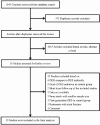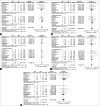Drug-Eluting Balloon versus New-Generation Drug-Eluting Stent for the Treatment of In-Stent Restenosis: An Updated Systematic Review and Meta-Analysis
- PMID: 29483397
- PMCID: PMC5850679
- DOI: 10.4103/0366-6999.226073
Drug-Eluting Balloon versus New-Generation Drug-Eluting Stent for the Treatment of In-Stent Restenosis: An Updated Systematic Review and Meta-Analysis
Abstract
Background: Currently, drug-eluting balloon (DEB) appears to be an attractive alternative option for the treatment of in-stent restenosis (ISR). Nevertheless, the clinical outcomes of DEB have seldom been compared to those of new-generation drug-eluting stent (DES). Thus, this meta-analysis aimed to evaluate the safety and efficacy of DEB compared to those of new-generation DES in the treatment of ISR.
Methods: A comprehensive search of electronic databases including PubMed, EMBASE, and Cochrane Library up to November 2, 2017 was performed to identify pertinent articles comparing DEB to new-generation DES for the treatment of ISR. In addition, conference proceedings for the scientific sessions of the American College of Cardiology, American Heart Association, European Society of Cardiology, Transcatheter Cardiovascular Therapeutics, and EuroPCR were also searched. The primary endpoint was target lesion revascularization (TLR) at the longest follow-up. Dichotomous variables were presented as risk ratios (RR s) with 95% confidence intervals (CI s), while the overall RR s were estimated using the Mantel-Haenszel random-effects model.
Results: Five randomized controlled trials (RCTs) and eight observational studies involving 2743 patients were included in the present meta-analysis. Overall, DEB was comparable to new-generation DES in terms of TLR (RR = 1.24, 95% CI: 0.89-1.72, P = 0.21), cardiac death (RR = 1.55, 95% CI: 0.89-2.71, P = 0.12), major adverse cardiovascular event (RR = 1.21, 95% CI: 0.98-1.48, P = 0.07), myocardial infarction (RR = 1.12, 95% CI: 0.72-1.76, P = 0.62), and stent thrombosis (RR = 0.95, 95% CI: 0.38-2.42, P = 0.92). However, DEB was associated with higher risk of all-cause mortality than new-generation DES (RR = 1.65, 95% CI: 1.09-2.50, P = 0.02). This was especially true in the real-world observational studies (RR = 1.79, 95% CI: 1.12-2.88, P = 0.02). In RCTs, however, no significant difference was found between the two treatment strategies in the risk of all-cause mortality.
Conclusions: The current meta-analysis showed that DEB and new-generation DES had comparable safety and efficacy for the treatment of ISR in RCTs. However, treatment with DEB was associated with higher risk of all-cause mortality in the real-world nonrandomized studies.
药物洗脱球囊与新型药物洗脱支架治疗支架内再狭窄的对比:一项更新的系统性回顾和荟萃分析摘要背景:当前,使用药物洗脱球囊可能是治疗支架内再狭窄的新方法,但是药物洗脱球囊与新型药物洗脱支架治疗支架内再狭窄的临床研究较少。因此,本研究旨在对药物洗脱球囊与新型药物洗脱支架治疗支架内再狭窄的安全性与有效性进行对比。 方法:从PubMed、EMBASE和Cochrane Library三大数据库中充分检索药物洗脱球囊与新型药物洗脱支架治疗支架内再狭窄对比的研究,检索截止时间为2017年11月2日。此外,也对美国心脏病学会(ACC)、美国心脏协会(AHA)、欧洲心脏病学会(ESC)、经导管心血管治疗(TCT)和欧洲血运重建大会(EuroPCR)等会议的会议论文进行检索。主要终点为最长随访时间的靶血管血运重建发生率。二分变量用风险比(RR)和95%置信区间(CI)表示,采用Mantel-Haenszel随机效应模型对总体RR进行估计。 结果:5项前瞻性随机对照研究和8项观察性研究共2743例患者入选。与新型药物洗脱支架相比,药物洗脱球囊组的靶病变血运重建(RR = 1.24, 95% CI: 0.89-1.72, P = 0.21)、心源性死亡(RR = 1.55, 95% CI: 0.89-2.71, P = 0.12)、主要不良心血管事件(RR = 1.21, 95% CI: 0.98-1.48, P = 0.07)、心肌梗死(RR = 1.12, 95% CI: 0.72-1.76, P = 0.62)和支架内血栓(RR = 0.95, 95% CI: 0.38-2.42, P = 0.92)发生率无明显差异。但是药物洗脱球囊组患者的全因死亡率高于新型药物洗脱支架组(RR = 1.65, 95% CI: 1.09-2.50, P = 0.02),这主要是由于真实世界观察性研究的结果导致的(RR = 1.79, 95% CI: 1.12-2.88, P = 0.02)。在前瞻性随机对照研究中,两种治疗方式间的全因死亡率没有明显差别。 结论:这项荟萃分析发现在前瞻性随机对照研究中,药物洗脱球囊和新型药物洗脱支架治疗支架内再狭窄的安全性和有效性相当。但在真实世界研究中,接受药物洗脱球囊治疗患者的全因死亡率更高。.
Keywords: Drug-Eluting Balloon; In-Stent Restenosis; Meta-Analysis; New-Generation Drug-Eluting Stent.
Conflict of interest statement
There are no conflicts of interest.
Figures




References
-
- Qin Z, Zheng FW, Zeng C, Zhou K, Geng Y, Wang JL, et al. Elevated levels of very low-density lipoprotein cholesterol independently associated with in-stent restenosis in diabetic patients after drug-eluting stent implantation. Chin Med J. 2017;130:2326–32. doi: 10.4103/0366-6999.213575. - PMC - PubMed
-
- Lee JM, Park J, Kang J, Jeon KH, Jung JH, Lee SE, et al. Comparison among drug-eluting balloon, drug-eluting stent, and plain balloon angioplasty for the treatment of in-stent restenosis: A network meta-analysis of 11 randomized, controlled trials. JACC Cardiovasc Interv. 2015;8:382–94. doi: 10.1016/j.jcin.2014.09.023. - PubMed
-
- Liu R, Xiong F, Wen Y, Ma YL, Yao Y, Gao Z, et al. Comparison of efficacy and safety between first and second generation drug-eluting stents in patients with stable coronary artery disease: A Single-center retrospective study. Chin Med J. 2017;130:1654–61. doi: 10.4103/0366-6999.209904. - PMC - PubMed
-
- Palmerini T, Benedetto U, Biondi-Zoccai G, Della Riva D, Bacchi-Reggiani L, Smits PC, et al. Long-term safety of drug-eluting and Bare-metal stents: Evidence from a comprehensive network meta-analysis. J Am Coll Cardiol. 2015;65:2496–507. doi: 10.1016/j.jacc.2015.04.017. - PubMed
-
- Scheller B, Speck U, Abramjuk C, Bernhardt U, Böhm M, Nickenig G, et al. Paclitaxel balloon coating, a novel method for prevention and therapy of restenosis. Circulation. 2004;110:810–4. doi: 10.1161/01.CIR.0000138929.71660.E0. - PubMed
Publication types
MeSH terms
LinkOut - more resources
Full Text Sources
Other Literature Sources

